Root Bundle
Who Really Owns Root Company?
Understanding who owns a company is crucial for grasping its strategic direction and future potential. This is especially true for Root, Inc., a tech-driven company that has disrupted the traditional insurance industry. Founded in 2015, Root aimed to revolutionize auto insurance through mobile technology and data-driven assessments of driving behavior.
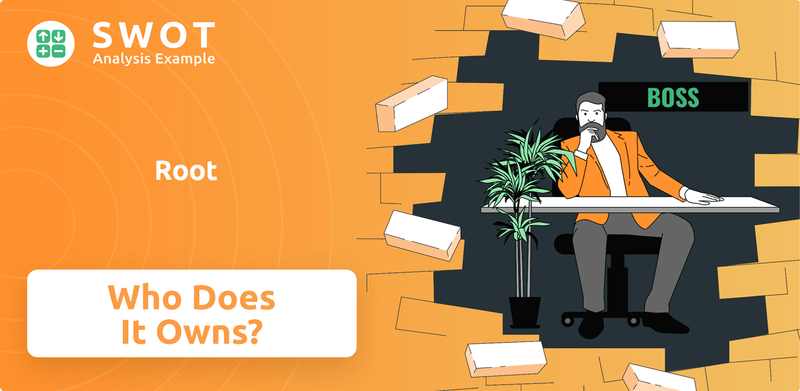
As a publicly traded entity on the Nasdaq, understanding the Root SWOT Analysis and its ownership structure offers valuable insights into its operations. This analysis examines the evolution of Root's ownership, from its founders to the current mix of institutional and individual shareholders. Knowing the Root Insurance owner and the company's key investors is essential for anyone evaluating its market position and future prospects.
Who Founded Root?
The insurance company, was co-founded in 2015 by Alex Timm and Dan Manges. Alex Timm, as CEO, brought expertise in actuarial science, while Dan Manges, as CTO, contributed his tech and software development skills. The initial ownership breakdown isn't public for early-stage private companies, but founders typically hold a significant share, often with vesting schedules.
Early funding for the company came from angel investors and venture capital firms. Drive Capital, based in Columbus, led the seed round. These early agreements likely included standard venture capital terms, like preferred stock and board representation, to protect early investors. The founders maintained operational control while bringing in financial partners to help grow the business.
The founders' vision of using technology to personalize insurance rates was central to attracting early investors. This vision shaped the initial distribution of control, with the founders maintaining operational control while bringing in strategic financial partners. The company aimed to disrupt the insurance industry by using data analytics and telematics to offer more accurate and personalized insurance rates.
Alex Timm, the CEO, had a background in actuarial science.
Drive Capital, a Columbus-based venture capital firm, led the seed round.
The company focused on using technology to personalize insurance rates.
The initial equity split isn't publicly detailed for early-stage private companies.
Early backing came from angel investors and venture capital firms.
The founders maintained operational control while bringing in strategic financial partners.
Understanding the company's ownership structure is key to assessing its long-term strategy. The company's focus on technology and data analytics has attracted investors looking to disrupt the insurance industry. For more details on how the company operates, you can explore the Revenue Streams & Business Model of Root.
Root SWOT Analysis
- Complete SWOT Breakdown
- Fully Customizable
- Editable in Excel & Word
- Professional Formatting
- Investor-Ready Format
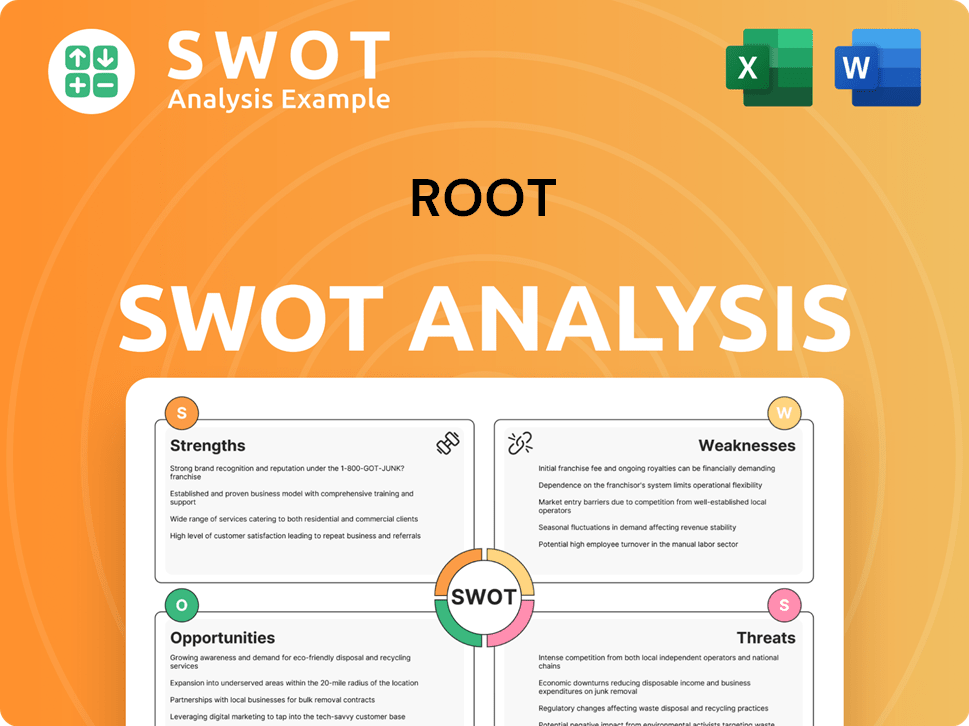
How Has Root’s Ownership Changed Over Time?
The path of the [Company Name] from a private startup to a publicly traded entity began on October 28, 2020. This was when the company launched its Initial Public Offering (IPO) on the Nasdaq Global Select Market, using the ticker symbol 'ROOT'. The IPO successfully raised approximately $724 million, establishing an initial market capitalization of around $6.7 billion. This transition marked a significant shift in the company's ownership structure, opening it up to a broader range of investors.
Following the IPO, the ownership of [Company Name] has evolved, typical of public companies. Major shareholders now include a mix of institutional investors, mutual funds, index funds, and individual insiders such as founders and executives. This diversification reflects the changing landscape of the company's financial backing and strategic direction. The shift in ownership structure has implications for company strategy and governance, especially as large institutional investors often engage with management on corporate governance and financial performance.
| Event | Date | Impact on Ownership |
|---|---|---|
| Initial Private Funding Rounds | Pre-2020 | Venture capital firms and early investors acquired significant stakes. |
| Initial Public Offering (IPO) | October 28, 2020 | Company went public; shares available to a wider investor base, including institutional investors and the public. |
| Post-IPO Shareholder Activity | 2021-2024 | Institutional investors, mutual funds, and index funds increased their holdings; individual insider ownership may have changed. |
As of early 2025, key institutional holders of [Company Name] stock include firms like Vanguard Group Inc. and BlackRock Inc., known for their extensive holdings in index funds and ETFs. Other major stakeholders may include venture capital firms that invested before the IPO, maintaining significant stakes. For instance, strategic investors, such as Berkshire Hathaway's GEICO, have shown interest in the insurtech space. To find detailed information on the current major shareholders, one can refer to SEC filings, such as 13F reports, which are updated quarterly by institutional investment managers. Understanding the Growth Strategy of Root can also shed light on the company's financial backers.
The ownership structure of [Company Name] has evolved significantly since its IPO in 2020.
- Major shareholders now include institutional investors, mutual funds, and index funds.
- Vanguard and BlackRock are among the largest institutional holders.
- SEC filings provide the most current data on major shareholders.
- Understanding the ownership structure is key to assessing company strategy and governance.
Root PESTLE Analysis
- Covers All 6 PESTLE Categories
- No Research Needed – Save Hours of Work
- Built by Experts, Trusted by Consultants
- Instant Download, Ready to Use
- 100% Editable, Fully Customizable
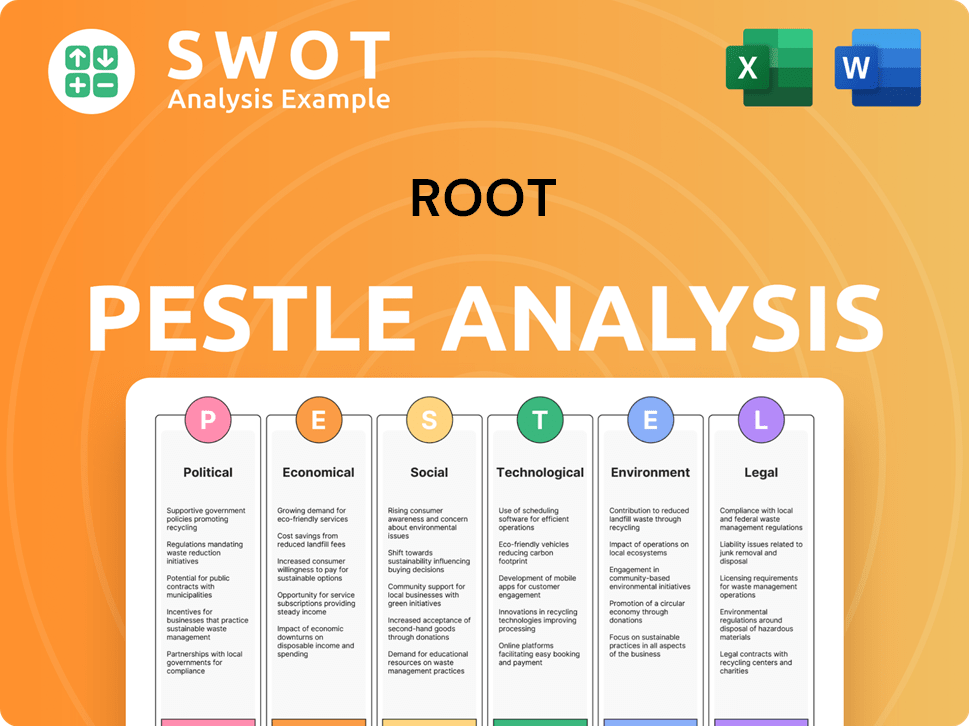
Who Sits on Root’s Board?
As of early 2025, the Board of Directors of Root, Inc. oversees the company's operations and reflects its ownership structure. The board includes a mix of independent directors, representatives of major shareholders, and executive officers, including the CEO. Alex Timm, co-founder and CEO, is a board member. Other directors have backgrounds in finance, technology, and insurance. Some may represent significant institutional investors or bring expertise and independence to the table. Directors associated with early venture capital investors, such as Drive Capital, may hold board seats. Independent directors are appointed to ensure diverse perspectives and oversight. Understanding the Marketing Strategy of Root can offer additional insights into the company's direction.
The board's composition and the influence of various stakeholders are essential to understanding Root Company ownership. The board's role includes making strategic decisions, overseeing executive compensation, and ensuring compliance with regulations. The board's composition, including independent directors and representatives of major shareholders, helps in balancing different interests and perspectives. The board's structure reflects the company's commitment to good corporate governance and transparency.
| Board Member | Title | Affiliation |
|---|---|---|
| Alex Timm | Co-founder, CEO | Root, Inc. |
| Daniel Rosenthal | Director | Drive Capital |
| Christine A. B. Edwards | Director | Independent |
Root's voting structure generally follows the one-share-one-vote principle. Each share of common stock entitles its holder to one vote on shareholder matters. There is no public information indicating dual-class shares or arrangements that would grant outsized control to specific individuals. Institutional shareholders hold significant voting power due to their large stakes. The influence of large institutional investors can be significant in shaping strategic decisions and executive compensation. Recent proxy battles or activist investor campaigns against Root have not been prominently reported, suggesting a relatively stable governance environment. Understanding the Root Insurance owner and Root Company ownership is key.
The Board of Directors at Root, Inc. includes the CEO, independent directors, and representatives from major shareholders. The voting structure is primarily one-share-one-vote, with no special arrangements for disproportionate control.
- The board includes a mix of independent directors, shareholder representatives, and executives.
- The voting structure is generally one-share-one-vote.
- Major institutional investors have significant influence.
- No single entity or individual is reported to have disproportionate control.
Root Business Model Canvas
- Complete 9-Block Business Model Canvas
- Effortlessly Communicate Your Business Strategy
- Investor-Ready BMC Format
- 100% Editable and Customizable
- Clear and Structured Layout
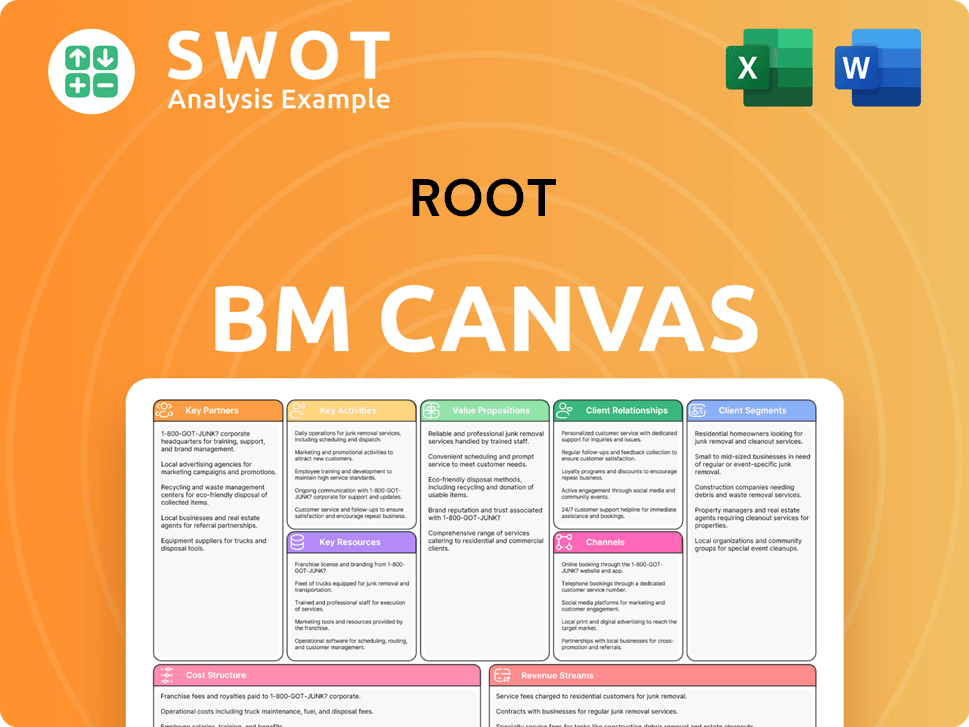
What Recent Changes Have Shaped Root’s Ownership Landscape?
Over the past few years (2022-2025), the ownership landscape of Root has evolved. As a publicly traded insurtech, it has navigated market volatility and industry-specific challenges. The company has prioritized operational improvements and achieving profitability, rather than focusing on share buybacks or major secondary offerings. There have been no significant mergers or acquisitions of the company itself. Leadership has remained relatively stable, with co-founder Alex Timm still serving as CEO, which has likely helped maintain investor confidence.
Industry trends show a rise in institutional ownership within the insurtech sector as these companies mature. Founder dilution is a natural aspect of multiple funding rounds and IPOs. The company has not been a prominent target of activist investor campaigns. Discussions around profitability and market share growth directly impact investor sentiment and thus ownership trends. Root's financial performance, including efforts to reduce losses and achieve underwriting profitability in 2024 and early 2025, are key factors influencing its ownership profile and investor confidence. The company's focus on these areas is crucial for maintaining and potentially increasing investor interest.
The company's stock price has fluctuated, reflecting the challenges and opportunities within the insurtech market. As of early 2024, Root's stock price has shown volatility, which is a common characteristic of growth-stage companies. The company's strategy to achieve profitability and improve its financial performance is a key factor influencing investor sentiment and, consequently, ownership trends. For more information, you can explore the details about Root Company ownership.
Institutional ownership is increasing in the insurtech sector. Founder dilution is a natural outcome of public offerings. The company is focused on profitability.
Root's financial results, including efforts to reduce losses, strongly influence investor confidence. The company's stock price reflects market conditions and performance. Achieving underwriting profitability is a primary goal.
Co-founder Alex Timm's continued role as CEO provides stability. Leadership changes can influence investor sentiment. Executive stability can build trust.
The company's strategy includes partnerships and growth opportunities. Public statements about future plans are closely monitored. Investors watch for long-term strategy details.
Root Porter's Five Forces Analysis
- Covers All 5 Competitive Forces in Detail
- Structured for Consultants, Students, and Founders
- 100% Editable in Microsoft Word & Excel
- Instant Digital Download – Use Immediately
- Compatible with Mac & PC – Fully Unlocked
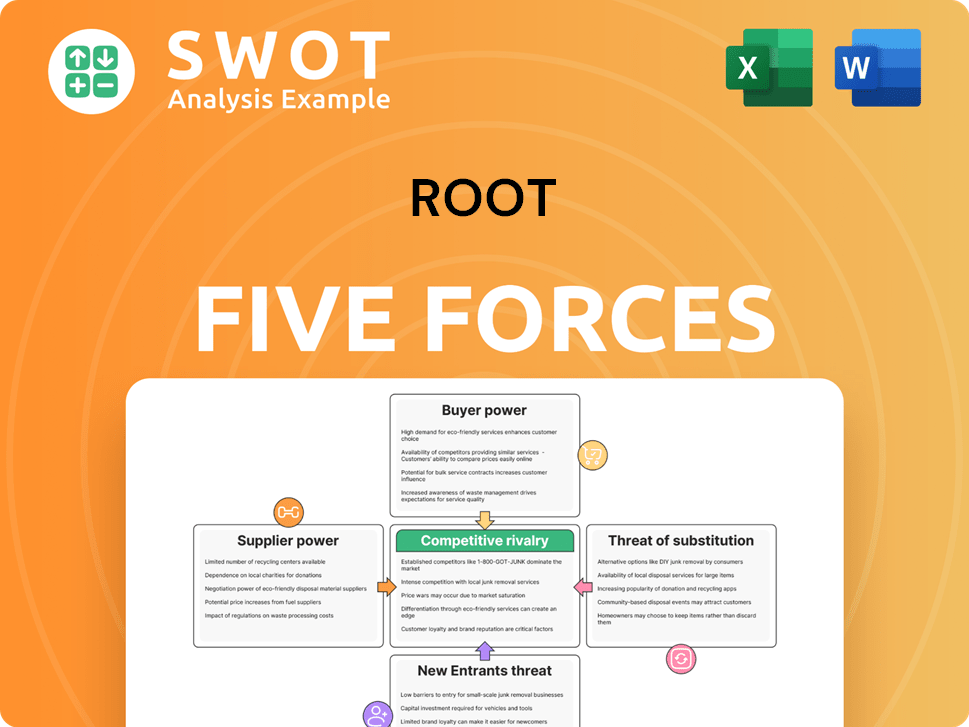
Related Blogs
- What are Mission Vision & Core Values of Root Company?
- What is Competitive Landscape of Root Company?
- What is Growth Strategy and Future Prospects of Root Company?
- How Does Root Company Work?
- What is Sales and Marketing Strategy of Root Company?
- What is Brief History of Root Company?
- What is Customer Demographics and Target Market of Root Company?
Disclaimer
All information, articles, and product details provided on this website are for general informational and educational purposes only. We do not claim any ownership over, nor do we intend to infringe upon, any trademarks, copyrights, logos, brand names, or other intellectual property mentioned or depicted on this site. Such intellectual property remains the property of its respective owners, and any references here are made solely for identification or informational purposes, without implying any affiliation, endorsement, or partnership.
We make no representations or warranties, express or implied, regarding the accuracy, completeness, or suitability of any content or products presented. Nothing on this website should be construed as legal, tax, investment, financial, medical, or other professional advice. In addition, no part of this site—including articles or product references—constitutes a solicitation, recommendation, endorsement, advertisement, or offer to buy or sell any securities, franchises, or other financial instruments, particularly in jurisdictions where such activity would be unlawful.
All content is of a general nature and may not address the specific circumstances of any individual or entity. It is not a substitute for professional advice or services. Any actions you take based on the information provided here are strictly at your own risk. You accept full responsibility for any decisions or outcomes arising from your use of this website and agree to release us from any liability in connection with your use of, or reliance upon, the content or products found herein.